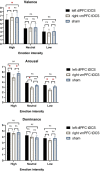The role of dorsolateral and ventromedial prefrontal cortex in the processing of emotional dimensions
- PMID: 33479323
- PMCID: PMC7819980
- DOI: 10.1038/s41598-021-81454-7
The role of dorsolateral and ventromedial prefrontal cortex in the processing of emotional dimensions
Abstract
The ventromedial and dorsolateral prefrontal cortex are two major prefrontal regions that usually interact in serving different cognitive functions. On the other hand, these regions are also involved in cognitive processing of emotions but their contribution to emotional processing is not well-studied. In the present study, we investigated the role of these regions in three dimensions (valence, arousal and dominance) of emotional processing of stimuli via ratings of visual stimuli performed by the study participants on these dimensions. Twenty- two healthy adult participants (mean age 25.21 ± 3.84 years) were recruited and received anodal and sham transcranial direct current stimulation (tDCS) (1.5 mA, 15 min) over the dorsolateral prefrontal cortex (dlPFC) and and ventromedial prefrontal cortex (vmPFC) in three separate sessions with an at least 72-h interval. During stimulation, participants underwent an emotional task in each stimulation condition. The task included 100 visual stimuli and participants were asked to rate them with respect to valence, arousal, and dominance. Results show a significant effect of stimulation condition on different aspects of emotional processing. Specifically, anodal tDCS over the dlPFC significantly reduced valence attribution for positive pictures. In contrast, anodal tDCS over the vmPFC significantly reduced arousal ratings. Dominance ratings were not affected by the intervention. Our results suggest that the dlPFC is involved in control and regulation of valence of emotional experiences, while the vmPFC might be involved in the extinction of arousal caused by emotional stimuli. Our findings implicate dimension-specific processing of emotions by different prefrontal areas which has implications for disorders characterized by emotional disturbances such as anxiety or mood disorders.
Conflict of interest statement
MAN is a member of the Scientific Advisory Boards of Neuroelectrics and NeuroDevice. All other authors declare no competing interests.
Figures



Similar articles
-
The role of ventromedial and dorsolateral prefrontal cortex in attention and interpretation biases in individuals with general anxiety disorder (GAD): A tDCS study.J Psychiatr Res. 2021 Dec;144:269-277. doi: 10.1016/j.jpsychires.2021.10.034. Epub 2021 Oct 22. J Psychiatr Res. 2021. PMID: 34710663 Clinical Trial.
-
The role of the dorsolateral and ventromedial prefrontal cortex in emotion regulation in females with major depressive disorder (MDD): A tDCS study.J Psychiatr Res. 2022 Apr;148:149-158. doi: 10.1016/j.jpsychires.2022.01.030. Epub 2022 Jan 20. J Psychiatr Res. 2022. PMID: 35124394
-
Transcranial direct current stimulation enhances cognitive control during emotion regulation.Brain Stimul. 2014 Jan-Feb;7(1):105-12. doi: 10.1016/j.brs.2013.08.006. Epub 2013 Sep 21. Brain Stimul. 2014. PMID: 24095257 Clinical Trial.
-
Attention bias modification through transcranial direct current stimulation (tDCS): A review.Neurophysiol Clin. 2022 Oct;52(5):341-353. doi: 10.1016/j.neucli.2022.09.002. Epub 2022 Oct 12. Neurophysiol Clin. 2022. PMID: 36241563 Review.
-
Prefrontal but not cerebellar tDCS attenuates renewal of extinguished conditioned eyeblink responses.Neurobiol Learn Mem. 2020 Apr;170:107137. doi: 10.1016/j.nlm.2019.107137. Epub 2019 Dec 12. Neurobiol Learn Mem. 2020. PMID: 31838223 Review.
Cited by
-
Self-Positivity or Self-Negativity as a Function of the Medial Prefrontal Cortex.Brain Sci. 2021 Feb 19;11(2):264. doi: 10.3390/brainsci11020264. Brain Sci. 2021. PMID: 33669682 Free PMC article.
-
Genetic polymorphisms and their association with neurobiological and psychological factors in anorexia nervosa: a systematic review.Front Psychol. 2024 Jun 21;15:1386233. doi: 10.3389/fpsyg.2024.1386233. eCollection 2024. Front Psychol. 2024. PMID: 38979077 Free PMC article.
-
Dissociating the role of dACC and dlPFC for emotion appraisal and mood regulation using cathodal tDCS.Cogn Affect Behav Neurosci. 2022 Apr;22(2):304-315. doi: 10.3758/s13415-021-00952-3. Epub 2021 Oct 21. Cogn Affect Behav Neurosci. 2022. PMID: 34676495
-
The efficacy of transcranial direct current stimulation in the treatment of anorexia nervosa: a randomized double-blind clinical trial.Front Psychiatry. 2024 May 2;15:1284675. doi: 10.3389/fpsyt.2024.1284675. eCollection 2024. Front Psychiatry. 2024. PMID: 38757134 Free PMC article.
-
Repeated prefrontal tDCS for improving mental health and cognitive deficits in multiple sclerosis: a randomized, double-blind, parallel-group study.J Transl Med. 2024 Sep 13;22(1):843. doi: 10.1186/s12967-024-05638-1. J Transl Med. 2024. PMID: 39272101 Free PMC article. Clinical Trial.
References
-
- Kolb B, Whishaw IQ. Fundamentals of Human Neuropsychology. New York: Macmillan; 2009.
-
- Stuss DT, Benson DF. The Frontal Lobes. New York: Raven Pr; 1986.
Publication types
MeSH terms
LinkOut - more resources
Full Text Sources
Other Literature Sources
Medical

